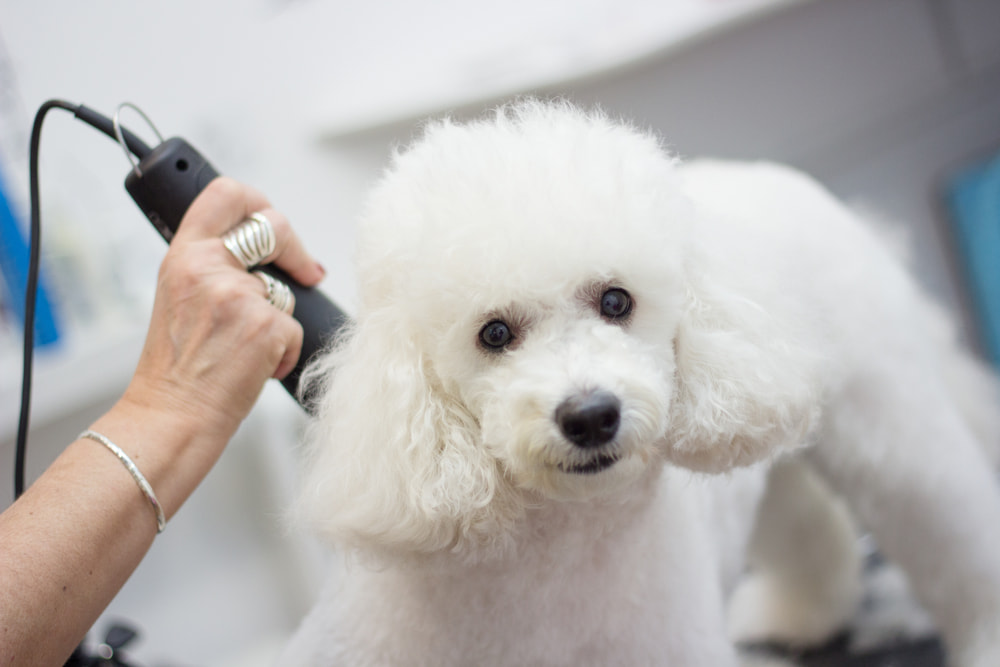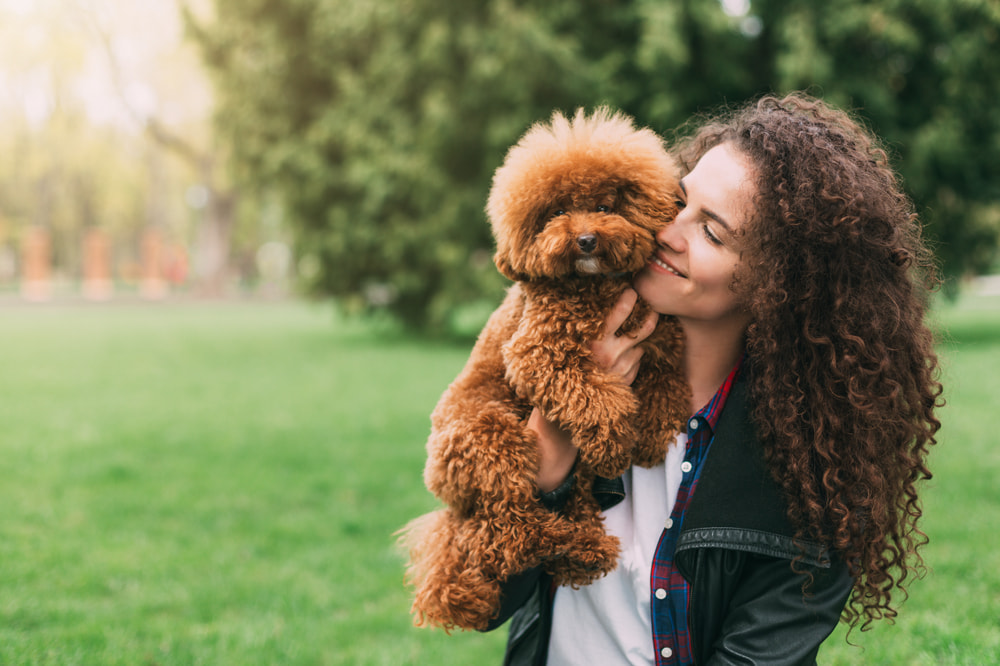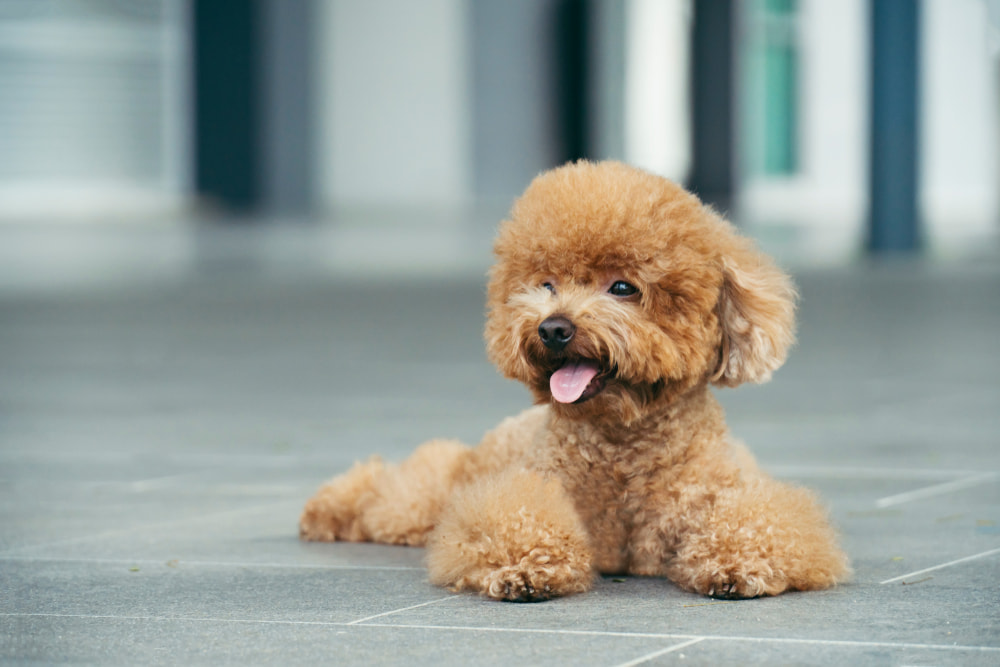Poodle

Breed Details
- Average Height: At least 15 inches (Standard); 10 to 15 inches (Miniature); under 10 inches (Toy).
- Average Weight: 45 to 70 pounds (Standard); 15 to 17 pounds (Miniature); 6 to 9 pounds (Toy)
- Coloring: Apricot, black, blue, brown, cream, grey, red, silver and white
- Coat Type: Curly or corded. Curly coats are dense with a harsh texture. Corded coats have naturally, tight cords of varying lengths.
- Dog Breed Group: Non-sporting group
- Average Lifespan: 12 to 15 years
- Key Personality Traits: Active, intelligent, easy to train
If you’re considering adding a Poodle to your family, it may surprise you to learn that this fluffy, posh-looking dog breed is actually quite athletic.
When Christian Latimer, a veterinary surgeon at Veterinary Referral Hospital of Hickory in North Carolina, wanted a running partner, he adopted a Poodle. His Standard Poodle, Gus, tackles long distances with ease thanks to a natural athleticism often overlooked in the breed.
“Gus loves to be on the move,” says Latimer. “A lot of people don’t realize that standard Poodles were bred as hunting dogs and do well with a lot of exercise.”
To learn more surprising and interesting facts and information about the Poodle dog breed, just keep on reading.
History and Origin

Poodles might be the national dog of France—earning them the popular moniker “French Poodle”—but the breed actually originated in Germany.
The name “Poodle” comes from the German word “pudel” or “pudelin” that means “splashing in the water” in honor of their heritage as a hunting breed.
Standard Poodles were bred to retrieve ducks and other waterfowl from the water—even their unusual haircuts were designed to make them better suited to being in cold water. The so-called poodle cut serves two functions: Having less hair on most of their bodies makes poodles better swimmers and the puffs of fur on their torsos and joints protect their vital organs from the cold water, according to Tarah Schwartz, author of “The Complete Guide to Poodles.”
Thanks to their above average intelligence, Poodles were also popular circus entertainers, performing for audiences under the big top throughout Europe. Poodles later gained favor among French nobles and the breed transitioned from hunters and entertainers to beloved family pets.
“As the breeding and showing of purebred dogs rose in popularity in the 19th century, the Poodle became somewhat of a status symbol,” Schwartz says. “It was bred down in size to create the Miniature and Toy varieties and fell out of favor with hunters. By the 20th century, the Poodle’s history as a hunting dog was all but forgotten as the breed gained popularity as companions and circus dogs, leading to the ‘frou-frou’ reputation you’re familiar with.”
Poodles were recognized by the American Kennel Club in 1887.
Types of Poodles

There are three types of Poodles:
- Standard
- Miniature
- Toy
Standard Poodles are at least 15 inches tall at the shoulder (though most Standard Poodles are between 22 and 27 inches tall) and weigh 45 to 70 pounds.
Miniature Poodles are between 10 and 15 inches tall and weigh 15 to 17 pounds.
Toy Poodles are the smallest Poodles, at heights under 10 inches and weighing between 6 to 9 pounds.
Poodle Physical Characteristics

Although Standard, Miniature and Toy Poodles are different sizes, they share similar physical characteristics, including square, well-proportioned builds and distinctive coats.
Poodles have either curly or corded coats. A curly coat is dense and harsh in texture while corded coats consist of fur that hangs in tight cords of varying lengths. Poodles with curly coats are more common, according to Latimer.
While most people probably envision a white Poodle when thinking about the dog breed, Poodle coats actually come in a variety of colors and hues. Common coat colors for Poodles include:
- Apricot
- Black
- Blue
- Brown
- Cream
- Grey
- Red
- Silver
- White
Poodle Personality Traits

Standard, Miniature and Toy Poodles might be very different in size, but Schwartz says their temperaments are quite similar. She describes the breed as highly intelligent, active, sociable and loyal.
Poodles develop strong bonds with their owners but Schwartz notes that it’s not uncommon for the dogs to be aloof around strangers. Once Poodles feel comfortable, the breed is known for being warm and loving. Schwartz adds that Poodles are “great with children” and are often used as service and therapy dogs because of their willingness to work and their desire to please.
Miniature and Toy Poodles are sometimes reputed to be snappy or neurotic but this often comes as a response to being under-socialized. Well trained, well socialized Poodles still make excellent watch dogs, Latimer says.
“They might be small but they will let you know if someone is coming,” he says.
As the adage goes, their barks are bigger than their bites. Poodles are known for being calm and loyal companions.
Poodle Care Guide

Poodles, like all breeds, require affection, regular exercise, balanced diets, and veterinary care to live long, healthy lives. To give the best care to your Poodle, consider the following advice:
Diet and Nutrition
There is no one-size-fits-all diet for Poodles. Latimer suggests talking to your veterinarian for the type of food and number of calories your Poodle needs. The recommendation will depend on size and weight, medical issues, and lifestyle factors. In general, a high quality commercial dog food and limited number of treats is sufficient for good Poodle nutrition.
Exercise and Activity
Poodles—even the Miniature and Toy varieties—need regular exercise. Latimer notes that Poodles of all sizes appreciate brisk walks and, thanks to their backgrounds as water dogs and retrievers, Poodles often enjoy supervised water activities and excel at games like fetch.
Incorporating regular training activities into their routine allows Poodles to exercise their bodies and minds, which is important for the intelligent, active dog breed.
“Don’t underestimate this breed’s need for physical and mental stimulation,” Schwartz adds. “Poodles need something to do or else they may develop destructive bad habits in an effort to entertain themselves. Even Toy Poodles are capable of keeping up with their humans on long walks, hikes, or other outdoor activities.”
Grooming and Nail Care
Regular grooming for Poodles is a must. Their coats should be brushed at least once a week to prevent matting. Latimer also recommends professional grooming every few months. A groomer can provide an all-over trim or a more traditional “Poodle cut” like a puppy clip or sporting clip.
To achieve the puppy clip, groomers shave the face, throat, feet, and base of the tail, leaving a pompom on the base of the tail. The sporting clip involves shaving the face, feet, throat, and base of tail—a pompom remains at the end of the tail and the body and legs are clipped to one inch in length (or less).
Latimer also recommends regular baths. Bathing once per month is sufficient for most Poodles but dogs that go hiking, swimming, or that enjoy rolling around in foul-smelling things should be bathed more often to remove dirt and debris from their coats.
Poodle Health Issues

Poodles are often healthy dogs that live long lives but the breed is prone to certain health conditions.
Hip dysplasia: Larger breeds, including Standard Poodles, are at higher risk for hip dysplasia, Latimer says. The condition is caused when the femur fails to align with the hip socket, causing pain and reducing quality of life.
Mitral valve disease: The disease occurs when the valves on the left side of the heart degenerate. Age is often the cause. “Smaller, fluffier breeds are more prone to mitral valve disease than other breeds,” Latimer says. “We see it often in Toy and Miniature Poodles.”
Eye issues: Poodles are prone to several issues, including optic nerve hypoplasia, a congenital condition that impairs the development of the optic nerve, often causing blindness. They may also suffer from progressive retinal atrophy, a disease that causes abnormal retinal cells, also causing blindness.
Bloat: Bloat is one of the biggest health risks for Standard Poodles due to their thin waists and deep chests, Latimer says. Bloat occurs when gas stretches the stomach, causing it to twist, which cuts off the blood supply to the stomach. It can be fatal. A procedure called a gastropexy that involves stitching the stomach to the side of the body wall can prevent bloat. Bloat is so common in Standard Poodles that Latimer recommends having a gastropexy done during spay/neuter surgery as a preventive measure.
Interesting Poodle Facts

Poodles are popular with celebrities. Walt Disney, Lucille Ball, Jacqueline Kennedy and Marilyn Monroe all owned Poodle dogs.
But one of the biggest Poodle lovers was Elvis Presley. The King of Rock and Roll had a Poodle named Champagne while he was stationed in Germany and he gifted Poodles to the women he loved. He offered his wife Priscilla a Poodle named Honey and gave one of his early girlfriends, Anita Wood, a Toy Poodle named Little Bit.
In the early 18th century, a Poodle troupe performed and danced in London under the direction of their trainer, a performer named Crawley. The performance was called The Ball of Little Dogs and the star performers were named Marquis of Gaillerdain and Madame de Poncette.
In 1988, a team of Poodles traveled to Alaska to compete in the Iditarod Sled Dog Race. They were led by sled-dog racer John Suter. And while the Poodles finished a whole week after the winner of the race, the team of Standard Poodles made it to the finish line.
A Poodle’s coat never stops growing, which is why they need regular grooming. Poodle hair goes through a natural cycle, ending in breakage and loss just like human hair, but they don’t tend to shed in clumps like dogs with a fur coat (like a Golden Retriever, for example).
Popular Poodle Mixes

Poodles are prized for being intelligent and affectionate, which makes them a popular choice for crossbreeding.
The “Doodle” breeds are among the most popular. These include:
- Labradoodle (Standard Poodle crossed with a Labrador Retrievers)
- Goldendoodle (Standard Poodle mixed with a Golden Retriever)
- Bernedoodle (Standard Poodle mixed with a Bernese Mountain Dog)
Miniature and Toy Poodles are also cross-bred with Yorkshire Terriers to create Yorkipoos; Cocker Spaniels to create Cockapoos; and Maltese to create Maltipoos.
Poodle Adoption: Tips and Things to Consider

If you want to adopt a Poodle, skip the shelter and humane societies and look for a breed-specific rescue instead.
Latimer adopted Gus from Carolina Poodle Rescue. There are a number of Poodle rescues nationwide, including:
Sites like Petfinder and How I Met My Dog allow you to search by breed, making it easier to find adoptable Poodles.
Not only will it be easier to find adoptable Poodles in a breed-specific rescue, Latimer believes that the staff and volunteers at Poodle rescues are passionate about the breed and can provide detailed information about the temperaments and health needs of the Poodles in their care.
Poodle FAQs

Before you bring a Poodle into your life and your home, it’s important to have answers to some of the most frequently asked questions about the breed. Let’s dive in, so you have all the information you need.
Are Poodles Hypoallergenic?
Poodles have less dander than other dog breeds, according to Latimer, but research published in the American Journal of Rhinology and Allergy found that dog allergen levels in homes with so-called hypoallergenic dogs, including Poodles, were no lower than allergen levels in homes with non-hypoallergenic breeds.
The American Kennel Club notes, “no dog is 100 percent hypoallergenic.” Poodles and other breeds with low-shedding coats produce less dander and are considered to be one of the “less allergenic” breeds.
Do Poodles Shed?
Poodles do not shed in the traditional sense. “Poodles have a hair coat and not a fur coat,” Latimer says. “Their hair doesn’t fall out.” While they may not shed in clumps, they can still experience hair breakage just like humans.
Are Poodles Smart?
In his book, “The Intelligence of Dogs,” author Stanley Coren, a renowned expert on dog-human interaction, listed Poodles as the second smartest dog breed (Border Collies topped the list). Schwartz describes Poodles as a “highly intelligent” dog breed.
What Were Poodles Bred For?
Although it may come as a surprise, Poodles were originally bred to be hunting dogs. Their jobs involved jumping into the water to retrieve ducks and other waterfowl.
Are Poodles Aggressive?
In a word, no. Poodles are not typically aggressive. “Poodles are calm and laid back and have no reputation for having aggressive temperaments,” says Latimer. That being said, any dog can be aggressive regardless of breed, which is why good training is always essential!
Pictures of Poodles
Browse our photo gallery to see pictures of Standard, Miniature, and Toy Poodles all in one place.




























